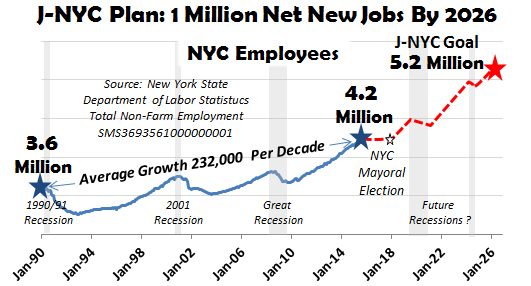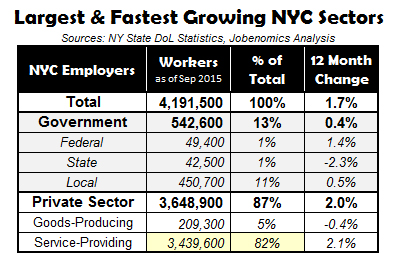Jobenomics-New York City
Jobenomics launches New York City initiative to create 1 million net new jobs in New York City over the next decade. This initiative is lead by Rev, Michel Faulkner, a former New York Jets NFL player, who started the Institute for Leadership in Harlem to identify and train potential small business startups in association with Jobenomics. Michel Faulkner is also a candidate for Mayor of New York and a former candidate for the U.S. Congress. (Faulkner for NYC Mayor Website at www.faulknerfornewyork.com). The following white paper describes the Jobenomics-New York City initiative.
Jobenomics-New York City
By: Rev. Michel J. Faulkner
Candidate for Mayor of New York City
17 November 2015
Download PDF version: Jobenomics New York City 19 November 2015. Jobenomics New York City White Paper 19 November 2015.
Also see: Faulkner for NYC Mayor, http://www.faulknerfornewyork.com/.
After ten years of effort, hundreds of meetings with policy-makers, thousands of meetings with business and community leaders and an outreach effort to over two million people, many Americans believe that the Jobenomics Plan for America is the most mature and comprehensive business and jobs creation plan in the United States. Charles D. (Chuck) Vollmer, author and founder of the Jobenomics national grassroots movement, has joined my campaign for mayor of New York City. Together, we are developing an actionable plan to create one million net new jobs in New York City within the next ten years via implementation of community-based business generators that will mass-produce tens of thousands of startup businesses.
Jobenomics deals with economics of business and job creation. Jobenomics national grassroots movement’s goal is to facilitate an economic environment that will create 20 million net new U.S. middle-class jobs within a decade. The movement has reached millions of people via its blog, reports, TV/radio, social media, lectures and word-of-mouth.
Research. Jobenomics produces a series of comprehensive reports including quarterly employment and unemployment reports that address the U.S. labor force, business and economic conditions. Jobenomics provides advice and timely data to policy-makers and decision-makers regarding business and job creation trends.
Focus Areas. While Jobenomics addresses big business and government employment, its principal focus is on highly-scalable small and self-employed businesses that employ 80% of all Americans and have produced 80% of all new jobs this decade. Women, minorities, new workforce entrants and the growing cadre of poor white males represent future business owners with the highest need and growth potential.
National-Level Initiatives. Jobenomics is leading two national-level initiatives called the Energy Technology Revolution (ETR) and the Network Technology Revolution (NTR). These initiatives could create 20 million net new American jobs within a decade. The ETR plan addresses emerging technologies, processes, systems and services across the entire energy spectrum for electrical power generation, transportation, storage and energy-related services. The NTR is characterized by a “perfect storm” of advanced technologies including: cloud computing, semantic webs, ubiquitous computing, advanced networks, machine learning, robotics, credentialing, Internet-of-Things and artificial intelligence agents. The NTR plan addresses America’s transition from a traditional to a digital economy and the transformational impact that the NTR will have on the economy, institutions, businesses and the labor force.
Jobenomics New York City (J-NYC): The J-NYC team is currently operating out of the Institute for Leadership facilities in Harlem (http://www.institute4leadership.com/). The initial draft of the J-NYC plan will be completed by mid-2016, depending on ongoing consensus building activities and community participation, and will be a “living” document with actionable and measurable milestones built on the framework of Jobenomics Plan for America. The J-NYC plan focuses on (1) NYC demographics with the greatest need and potential, (2) mass-producing startup businesses via community-based business generators, (3) attracting new highly-scalable businesses to NYC with emphasis on the network-centric and e-commerce firms, (4) forming alliances with countries, cities, corporations and entrepreneurs and (5) identifying sources of investment in order to achieve the one million net new jobs goal.
The J-NYC Business and Job Creation Plan’s objective is to quadruple the historical rate of NYC new job creation (232,000 per decade) with a goal of one million net new livable wage jobs by 2026. The plan concentrates on (1) implementing community-based business generators throughout the NYC metropolitan area, (2) developing workforce skillsets to fill vacant NYC jobs, (3) exploiting employment opportunities with the largest and fastest growing NYC industries, (4) implementing new business and job creation initiatives tailored to the needs of New Yorkers and (5) positioning the NYC labor force for substantial opportunities generated by energy and network technology revolutions.
J-NYC Community-Based Business Generator (J-CBBG) Concept. The solution to growing the NYC economy and labor force involves putting NYC’s small business engine into over-drive. Therefore, the J-NYC team will work with borough leaders to implement community-based business generators that will mass produce startups, extend the “life span” of fledgling firms and accelerate existing businesses. J-CBBGs will (1) identify and train potential small business owners and employees, (2) implement highly repeatable and scalable businesses with emphasis on the service-providing industries, (3) establish sources of startup funding, recurring funding and contracts to provide a consistent source of revenue for new businesses and (4) provide ongoing mentoring and support services.
Filling Open NYC Job Vacancies. As of November 2015, NYC’s five boroughs had 44,790 job vacancies.[1] 40,240 or 90% of the open positions are related to ten occupations: management, computer services, business and financial, sales, office support, healthcare, entertainment, social services, transportation and food services. Corporations with the largest number of open vacancies were Capital One, JP Morgan Chase, Oracle, King Teleservices and Deloitte with a total of 6,129 open positions. J-CBBGs will work with companies and occupational associations that have a vested interest in fulfilling these vacancies via training or certifying viable candidates with a specific skillset, or starting new businesses that can provide tailored services as subcontractors. The J-CBBGs will work with selected non-profits, such as employment-related institutions and churches (three Harlem mega-churches with over 250,000 parishioners have already agreed to support the J-CBBG concept), to perform the initial candidate due diligence. J-CBBGs will conduct further evaluations (Jobenomics and The Institute for Leadership already perform testing of this sort) to determine if candidates are ready for employment and capable of starting their own small business (self-employed, home-based, e-commerce, contractor, franchise, etc.). J-CBBGs will also build teams of future employees and future startup owners to increase camaraderie, accountability and successful launches.
Exploiting Employment Opportunities with the Largest and Fastest Growing NYC Sectors and Businesses. When preparing a labor force for maximum employment, J-NYC will begin with the largest and fastest growing sectors. NYC employs 4,191,500 workers. 542,000 (13%) work for government and 3,648,900 (87%) for the private sector. J-NYC’s business and job creation effort concentrates, but not exclusively, on private sector service-providing industries that are the largest (82%) employers of New Yorkers and the fastest growing segment (2.1%) of the major employment sectors. While the goods-producing segment (manufacturing, construction, mining) are vitally important, J-NYC feels that there is sufficient attention already being given to this segment that has limit upside employment potential as compared to services.
Within the NYC service-providing sector, the largest and fast growing industries are: Education and Health Services (866 million employees, 2.5% growth in the last year); Professional and Business Services (687M, 2.1% growth); Trade, Transportation and Utilities (631M, 1.4% growth); Financial Activities (459M, 1.9% growth); Leisure and Hospitality (427M, 3.2% growth) and Accommodation and Food Services (340M, 2.3% growth).[2] As a result of this data, J-NYC will work with NYC-based associations and companies in each of these industries to determine the level of interest and support for the J-NYC plan and their desire to engage with J-CBBG sponsorship, employee training and business startups. From our initial conversations with various corporate leaders, there is a keen interest in “feeder” facilities that can provide certified job candidates and independent contractors. Many would prefer to subcontract than hire.
New J-NYC Business and Job Creation Initiatives. J-NYC’s outreach program has already started identifying potential stakeholders for business and job creation initiatives for those struggling to make a livable wage. Most stakeholders say that they are eager to support any viable workfare over welfare initiatives. As the J-NYC plan matures new initiatives and programs will be added to the ones currently being pursued by J-NYC. J-NYC’s top three job creation initiatives are The Leadership Training Program, Urban Mining and Direct Care Centers.
- The Leadership Training Program is underway at the Institute for Leadership (IFL) and producing solid results. This program trains, empowers, and partners with leaders and organizations that are already in the community including church leaders, business executives, government officials, athletic coaches and others who function in positions of leadership. The program also is working with leaders on health reform, financial management and entrepreneur training. Perhaps, the greatest benefit of this program is that J-NYC has a solid base of community leaders willing and eager to support the maturing J-NYC plan.
- Urban Mining involves monetized urban waste streams such as municipal solid waste (MSW), construction and demolition material, tires and electronic waste. Waste is comprised of organic and nonorganic materials that can be reclaimed as commodities. J-NYC advocates a zero landfill/export policy and programs that convert waste into fertilizers, energy, biofuels and valuable raw materials. Jobenomics created eCyclingUSA LLC (http://ecyclingusa.com/) to help communities reclaim high value metals from electronic waste and use profits (average $30 million per year) for jobs and business creation. A typical eCyclingUSA plant can produce $30 million in profit and employ several hundred people. J-NYC is currently pursuing efforts to locate multiple eCyclingNYC facilities throughout the NYC metro that will hire the disadvantaged and formerly incarcerated.
- Direct Care Centers are oriented to training and starting home-based, self-employed businesses that provide in-home eldercare, healthcare and childcare services. Direct Care is ideal for struggling households run by women who are looking for work or supplemental income to support their families. One of the biggest reasons that single mothers are struggling financially is due to the cost of childcare. Direct Care centers can help free many single mothers to join the workforce by training and supervising other single mothers to care for a neighbor’s children for a fraction of the cost of other services. Direct Care Centers can also provide personnel and contract workers to large organizations, like New Partners, a subsidiary of Visiting Nurse Service of New York. The Direct Care Center concept is the next logical step in IFL’s health reform effort.
Energy Technology Revolution (ETR). The ETR will create hundreds of millions of jobs globally and millions for cities, like NYC, that embrace transformative energy technologies, processes, systems and services. Using Jobenomics’ comprehensive ETR report as a baseline, J-NYC is developing a strategy for the greater NYC metropolitan area in regards to the economic impact and employment potential of the ETR. For electrical power generation, J-NYC will evaluate the impact and challenges of cleaner fossil fuels, renewables, grid-level systems, point-of-use systems, greenhouse gas emissions, power density, storage, next-generation technologies, and investment. J-NYC also plans to form alliances with sister cities in California, Japan, China and Germany that are embracing their versions of the ETR. For example, Tokyo’s metropolis is similar to NYC in terms of power density and energy issues. Consequently, it would be prudent to take advantage of any Tokyo’s successful ETR pursuit that could fulfill a NYC energy need. For example, Tokyo Gas plans to install 2,500,000 energy efficient miniature point-of-use natural gas fuel cells in homes and apartments for power and heat generation. NYC can also learn from Germany’s Energiewende (German for energy transition) national initiative to transition Germany from fossil and nuclear fuels to renewable energy, California’s 2030 goal of having 50% of its electrical generation from renewables, and China’s extensive research in next generation ETR technology. In the transportation area, sister cities in these countries are leading the way in advanced vehicles, alternative fuels and advanced storage systems that could be applied to shaping the NYC energy ecosystem. In energy services sector, energy efficiency, energy conservation, energy security and Energy-as-a-Service (EaaS) businesses are growing at phenomenal rates and fertile areas for employment and startups. Over the last five years, the Institute for Leadership has participated in Jobenomics initiatives in the energy services sector including energy audits, weatherization and solar installation certification training. As a result, the IFL team believes that Jobenomics ETR plan is solid and will provide an excellent baseline for the J-NYC ETR plan, consensus building and collaborative engagement.
Network Technology Revolution (NTR). The NTR will create literally billions of new jobs globally as the digital economy takes root. Today, in terms of e-commerce, the overall U.S. economy is 5% digital and growing at 20% per year. The United Kingdom leads the world with a 12% digital economy followed by South Korea at 8% and China at 7%. China’s strategy to become the world’s leading digital economy is as breathtaking as it is comprehensive. China is attempting to replicate its manufacturing miracle of lifting 400 million people out of poverty in two decades by implementing a combined public/private e-commerce strategy to lift an equal amount of rural Chinese out of poverty by 2030. Alibaba Group, a Chinese conglomerate that recently (2014) had the largest Wall Street IPO in history, is positioning itself to be a global e-commerce leader by financing the creation of 10 million new Chinese network-centric microbusinesses. Other Chinese conglomerates and government institutions are pursuing similar efforts. J-NYC plans to collaborate with countries and companies like these, as well as U.S. corporate giants like Amazon, Google, Apple and Microsoft to help NYC create businesses and jobs in the rapidly growing digital economy. J-NYC is in the process of identifying hundreds of emerging companies that have the potential to create jobs and small businesses in the same way that Uber (cars for hire), AirBNB (rental accommodations) and WeWork (office space) has accomplished. Founded in 2010, WeWork is now the fastest-growing consumer of office space in 15 “high IQ” cities and is one of the largest office space providers in NYC. The NTR also has a very dark side. According to recent studies, computer automation can eliminate as much as 47% of the U.S. labor force in the next two decades. Automation has been replacing manual labor for years, but via the NTR cognitive skill jobs are increasing at risk. If there is any doubt just ask Apple’s Siri, Amazon’s Echo or IBM’s Watson. The J-NYC NTR plan will seek to mitigate potentially massive NYC labor force departures (due to automation or voluntary departures) by creating highly-scalable new jobs and businesses that can compete and prosper in the digital economy. The J-NYC NTR team will also work with existing businesses to adapt and harness the power of new NTR technologies, processes, systems and services to compete and prosper more effectively.
Funding. J-NYC will pursue various sources of funding. The Institute for Leadership has an initial bank pledge of $20 million for micro-business loans up to $50,000 for each new J-NYC small business created. Other potential sources of funding include government bonds, debt/equity financing, corporate sponsorships, crowd funding and impact investing. Impact investing refers to investments made to organizations that generate a measurable, beneficial social impact. Socially conscious investing has grown in popularity with family foundations, philanthropic organizations, endowments, pensions, hedge funds, mutual funds and other financial institutions like Blackrock and Bain Capital. NYC has a plethora of “top 1%” organizations and philanthrocapitalists (philanthropists who see themselves as social investors) that could be encouraged to underwrite J-CBBGs for their service to the public good as well as their public relations value to their organizations.
Contact. The J-NYC team is interested in community leaders that are interested in workforce and small business development as outlined herein. Please contact me or the J-NYC team at 212.690.7748 and the address is 245 W. 135th Street, New York, NY 10030.
[1] New York State Department of Labor, Labor Statistics, 9 November 2015, https://www.labor.ny.gov/stats/nyc/
[2] New York State Department of Labor, Current Employment Estimates, https://labor.ny.gov/stats/lscesmaj.shtm




















